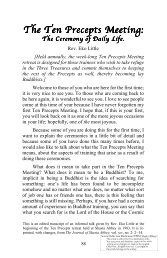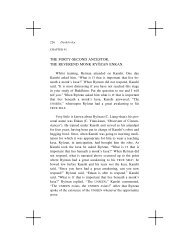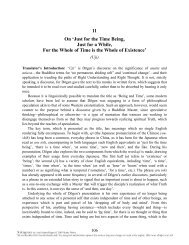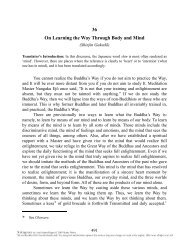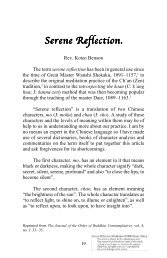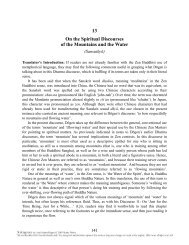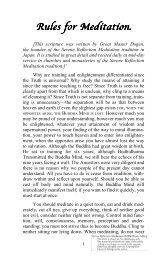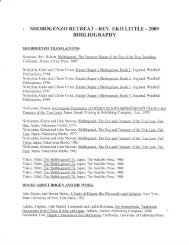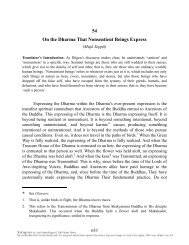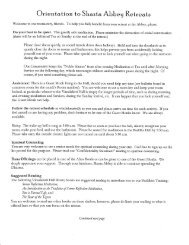Sesshin Sessho - thezensite
Sesshin Sessho - thezensite
Sesshin Sessho - thezensite
You also want an ePaper? Increase the reach of your titles
YUMPU automatically turns print PDFs into web optimized ePapers that Google loves.
Shōbōgenzō: On Expressing One’s True Nature by Expressing One’s Intent 537<br />
Tōzan replied, “He has revived from within death.” 12<br />
This phrase, ‘within death,’ points to having been able to pass directly into<br />
death. And Shinzan’s saying “It is Who,” which was not a casual remark, points<br />
directly to the condition of expressing his Nature by expressing his intent. This<br />
‘Who’ directs the person who is expressing His intention and expressing His True<br />
Nature. Something to explore through your training is the assertion that we do not<br />
necessarily anticipate a one hundred percent passing away into death. The Great<br />
Master’s statement, “He has revived from within death,” refers to the manifesting<br />
of sounds and forms before one’s very eyes, which expresses both intent and True<br />
Nature. And yet, even this will only be some ten or twenty percent of the entirety<br />
of passing away into death. Life, even though it is the totality of life, is not<br />
something wherein death is transformed and manifests as life. It is simply our<br />
letting go, from start to finish, of the notion of our ‘possessing’ life.<br />
In sum, in the words and ways of the Buddhas and Ancestors, there is an<br />
expressing of one’s intent and of one’s True Nature like that described above,<br />
which is to be thoroughly explored through one’s training. And to take this further,<br />
when we die a one hundred percent death, we have lived our life to the full.<br />
You need to realize that from the T’ang dynasty to today, there have been<br />
many pitiable creatures who have not clarified that expressing intention and<br />
expressing one’s True Nature is what the Buddha’s Way is about. Further, they<br />
have been going around in the dark about the Teachings, practice, and direct<br />
experience, and have therefore made reckless remarks and unfounded assertions.<br />
We need to help them overcome what they have been and to realize what they can<br />
be. For their sake, we say that expressing Their True Nature by expressing Their<br />
intent has been the essential function of the Seven Buddhas * along with our<br />
ancestral Masters.<br />
Delivered to the assembly in the first year of the Kangen era (1243) in Japan, at Kippō-ji Temple<br />
in the Yoshida Prefecture of Echizen Province.<br />
Copied by me on the eleventh day of the first lunar month in the second year of the same era<br />
(February 20, 1244) while at the office of the Abbot’s assistant.<br />
Ejō<br />
12. Whereas Dōgen begins by discussing this dialogue from the standpoint of the dropping off<br />
of self, he now discusses it from the point of view of dropping off ‘dropping off ’. In other<br />
words, since the concept of self is an illusion, there is nothing to be dropped off. However,<br />
we cannot know this until the time when the false ego has been let go of. At that time, we<br />
discover that ‘That Which Is’ is the One who has actually done the dropping off, for It has<br />
ever been the only true reality.





